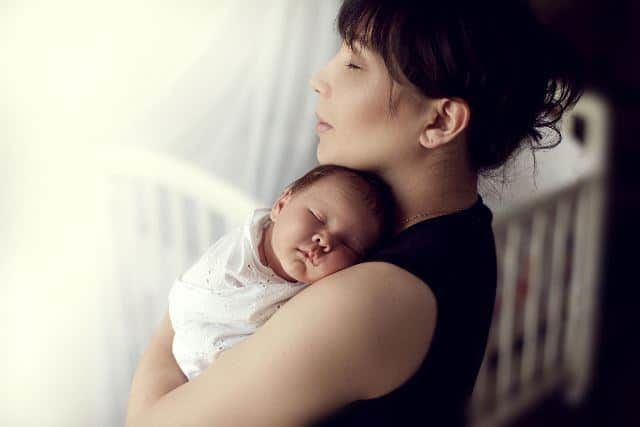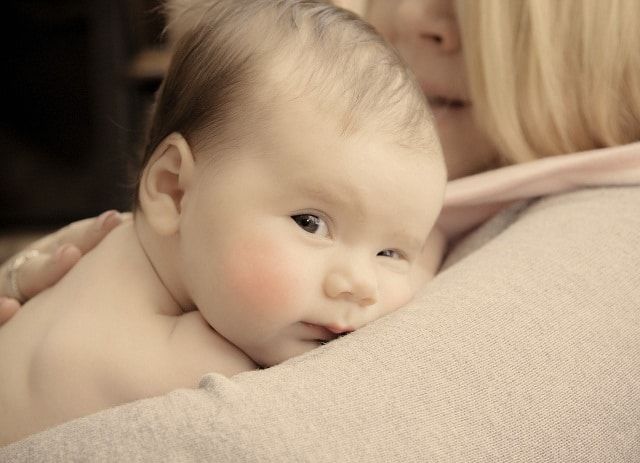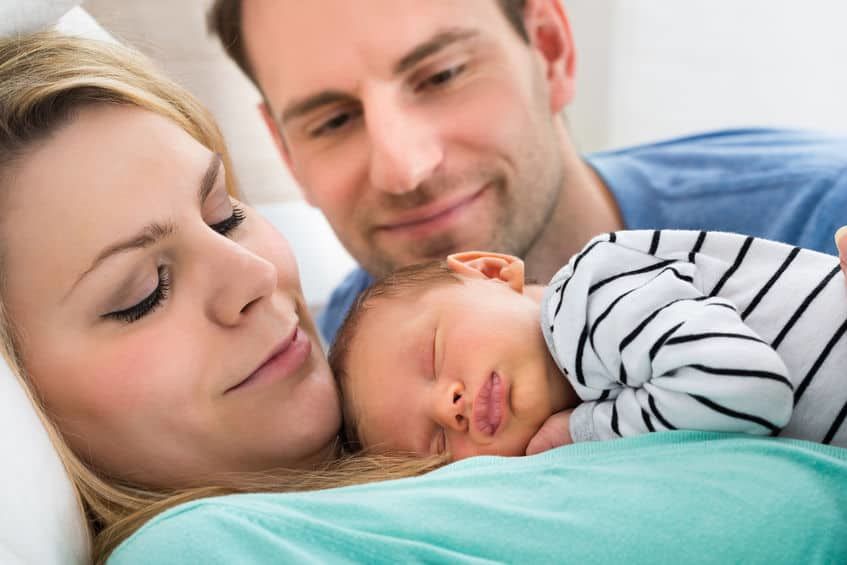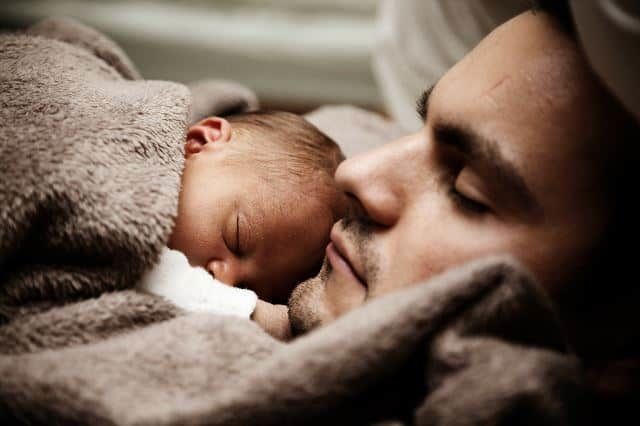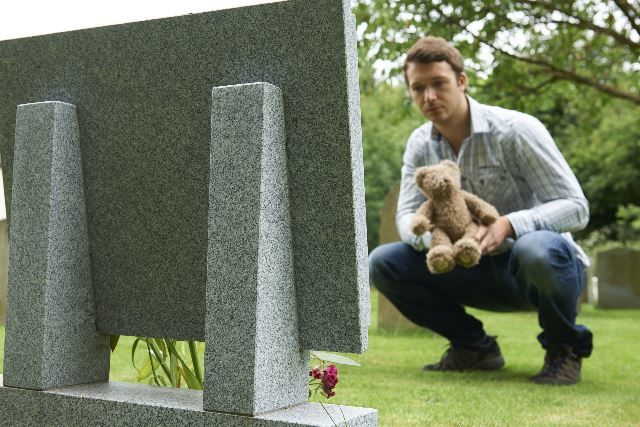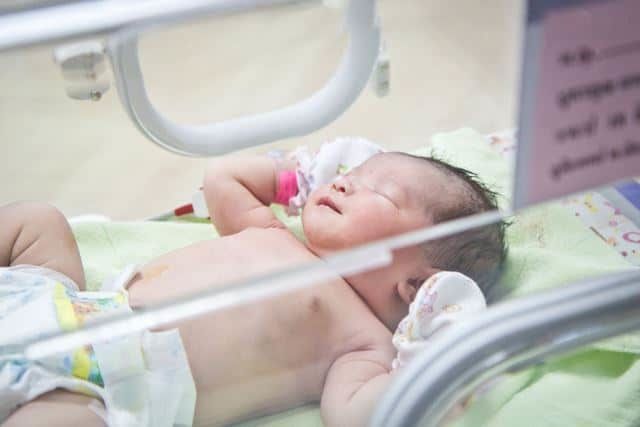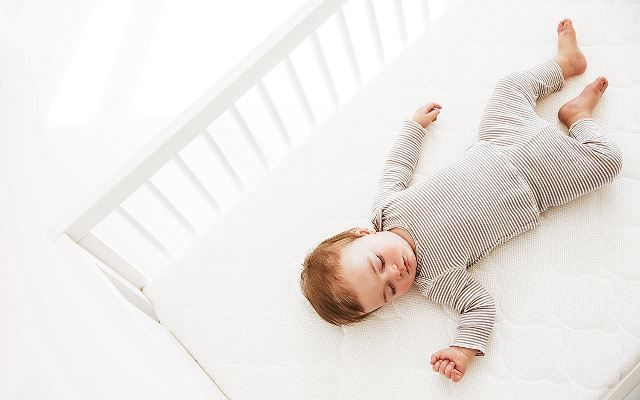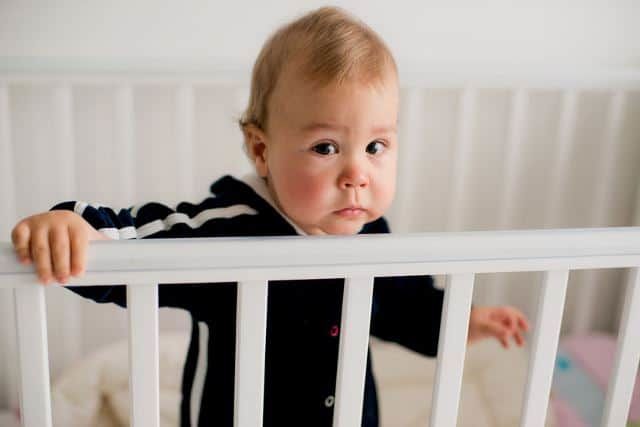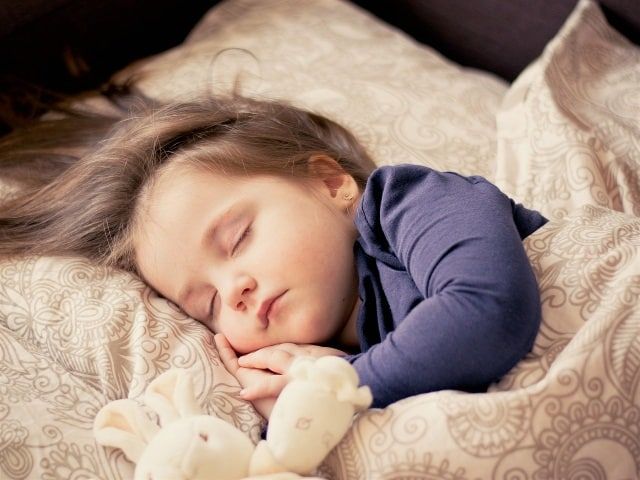Co-sleeping can be a controversial discussion and there are many articles online giving you conflicting information about the benefits of co-sleeping as well as some worrying information and blogs that are against it altogether.
With all this information, it can be easy to get confused or misinformed about co-sleeping. It is something which works for some families and doesn’t work for others.
But having all the facts will give you a good idea whether to try co-sleeping with your little one and see if that can change your sleeping habits for the better. We’ve put together a list of some of the pros and cons of co-sleeping so you are fully informed as to whether this arrangement is something that will work for your new family.
The information contained on The Sleep Judge is intended for informational and educational purposes only. We recommend consulting your doctor.
Pros and Benefits of Co-sleeping with Your Newborn
1. Comforts and Nurtures Your Baby
Many parents who co-sleep say it helps their baby develop and leads to less crying or distressed behavior from their newborn. If you look at most animals on the planet, most sleep together and wouldn’t separate their newest baby from the rest of the family while they were so young and vulnerable. The placing of a baby in a crib next to the bed, or even in the same bed, can reduce the baby’s anxiety which in turn will lead to a better quality of sleep and less disruptive sleep patterns.
While putting a baby to sleep can be a stressful time and many parents know the feeling of sitting on the nursery floor waiting for their little one to drop off, co-sleeping prevents this by having the baby in the same room so they automatically feel their parent’s presence and are comforted much easier.
A fussy child can be difficult to get to sleep and some babies wake up and immediately panic that their parents are not nearby. A co-sleeping arrangement means your baby may wake up but if they can hear you in the same room then they may well stir but go back to sleep on their own after a time.
2. Your Baby Feels Safer
Some children show signs of separation anxiety as early as around six or seven months old. You might find they scream when you leave the room, are reluctant to be cuddled by other members of the family or even seem “clingy”. This is a perfectly normal stage of development which every baby will go through to a degree.
At around this age, babies start to understand that people exist when they are not actually with them. This is called “object permanence”. This stage will pass but co-sleeping is often a way to reassure a baby through the night that the parents have not left them forever.
If your child is in another room, you may watch them on a monitor but to that child they don’t understand where you have gone. Even just being in the same room, within arm’s reach, means that as soon as your child starts to get anxious or worried you can spot it straight away and reach out to them.
This prevents the baby getting too worked up and crying which often wakes the entire house. While it is an upsetting time and particularly difficult if you are not getting much sleep, the phase usually only lasts until baby is two years old. Although that can feel very far away without much sleep!
You may be interested in: The Best Crib Mattresses For Your Baby.
3. It is Easier for Breastfeeding
For a breastfeeding mother, getting up four to five times in the night can be physically and mentally exhausting. Add to that the necessity to get out of bed, walk to the next room and comfort your child and you will be up on your feet a lot more often.
Co-sleeping means your baby is within arm’s reach so you won’t have to even fully get out of bed. This can help your baby get what they want quickly and easily as well as making sure you are able to get back to sleep afterward. There is a huge difference between getting up and walking around and staying snuggled under your covers.
The most important thing is to make sure baby is safely back where they are sleeping before you fall asleep, mothers can sometimes fall asleep while breastfeeding in bed and this increases the risk of your baby coming to harm.
You may be interested also in: When Can I Let My Baby Fall Asleep Through The Night Without Feeding?
4. Less Getting Up and Down in the Night (more sleep!)
Even if you’re not breastfeeding, you will still be woken through the night by your child who needs a diaper change, milk or just a cuddle and some comfort. By co-sleeping, you are right there and don’t need to get up to walk into another room and pick up your child. The baby’s first cries and murmurs will wake you so before they descend into a full-blown cry, you are there to give them whatever they need.
How many moms have fallen asleep on a nursery floor or in a chair nearby? By having the baby in the room with you, it means you will sleep easier as you know that if baby makes any noise or is crying out, you will wake quicker and be able to help them.
At six weeks old, you can start getting your baby and yourself!) into a proper sleep routine and by being close by you can help to make this stage less painful for you as you’re not forced to walk around the house. It can also help if you have other children who may wake with the noise of the baby as you catch the baby’s signs of distress earlier (when they are much quieter!)
5. Better for Skin to Skin Contact
Experts say skin to skin contact with your baby is one of the most important things to help them develop. All babies love to be cuddled, but skin to skin contact can help your child breastfeed more easily, prevent hypoglycemia and other newborn problems as well as promote brain development. In premature babies, skin to skin contact is vital to help them stabilize. In 1979, the benefits of skin to skin contact were almost accidentally discovered when at a hospital in Colombia the doctors ran out of incubators for premature babies.
In an attempt to keep them warm, they swaddled the babies and put them on their mother’s stomachs. An amazing thing happened where the babies thrived and were able to be discharged from hospital earlier than those in incubators. In newborns, their brains crave sensory stimulation and this contact can help the baby develop emotionally and socially. Co-sleeping means you are closer and more able to offer this kind of contact at points during the night. This will give your baby more time with you and strengthen the bond you have.
6. Helps a Mother Recover from Giving Birth Faster
With more than one in ten new mothers thought to suffer from postnatal depression, there are studies which say co-sleeping can actually prevent and help mothers going through this traumatic experience recover faster. Giving birth is a life-changing event and can be traumatic for any mother – whether it is their first baby or not.
If your little one has had a particularly difficult entrance to the world you can be left without the picture-perfect birth you had planned. There is no hard and fast rule that says co-sleeping is a “cure” for postnatal depression however so you should always contact your health visitor or GP if you believe you are suffering from symptoms.
Also, emergency caesareans and other medical necessities can leave you practically unable to get out of bed. If your baby is in another room, then you find yourself walking around a lot more. This can exacerbate healing wounds and pull stitches. By having baby close by, you can limit your activity and get the rest you need while also making sure your baby is comforted.
7. Bonding with a Child You Don’t See During the Day
As many parents know, you can’t always afford to give up work and stay with your newborn. This means that after maternity or paternity leave you could find yourself going back to work and being out of the house for eight or even 12 hours a day. This is heartbreaking for most people and it can affect the bond you have with your baby over time. Co-sleeping can be a way for your baby to feel close to you even though you are both sleeping. With a reported one in five mothers finding it difficult to bond with children, this extra time with your little one can be invaluable.
8. Stops Prolonged Crying
If you have other children or a partner that has to work long hours, then prolonged crying through the night can be stressful for everyone, especially during times of sleep regression. Not only is leaving a baby to cry considered harmful by some experts, but the noise alone can totally disrupt the household.
When a baby is in another room, they will have to call out louder to get your attention. Even if you are the lightest sleeper in the world it will still be hard to hear the telltale signs your baby is starting to stir from down the hallway. With co-sleeping, you’ll be nearby and able to comfort your baby quicker – eliminating the need for baby to cry out loudly to get your attention.
You may want to read: Know About Sleep Regression Stages
9. Deeper Sense of Love and Trust
By spending up to 12 hours in the same room with your baby, asleep or not, you are helping him to feel more secure and loved – some mothers say. Not every mother bonds with their baby straight away and it can take time to build up that sense of connection that everyone has with their child. Co-sleeping can help this bind develop into a deeper sense of love. As one mother says, she felt a “strong need” to sleep alongside her baby and now, even at six months old, she still loves sleeping at the same time as her child in the same room.
You may want to read: How to Make a Baby Fall Asleep Fast
Cons and Disadvantages of Co-sleeping with Baby
1. It Increases the Risk of SIDS
SIDS, or Sudden Infant Death Syndrome, is one of the scariest and most worrying aspects of being a new parent. SIDS is defined as a baby’s death that cannot be explained or a specific reason cannot be found.
There is research that suggests a link between co-sleeping and SIDS and while this is disputed and there are conflicting opinions there are a few things that can increase the risk. Some researchers from the National Centre for the Review and Prevention of Child Deaths in America looked into more than 8,000 unexplained deaths of babies and discovered that 74% of the children that died were bed-sharing.
As co-sleeping can be defined as sleeping in the same room within arm’s reach or “bed sharing” where the child is sleeping in the same bed as the parents we have to be clear that this research only found an issue where children were bed sharing.
As co-sleeping and bed sharing becomes more common, authorities are raising awareness of the best way to keep your baby close by and reduce the risk of SIDS as far as possible.
2. Risk from Drinking Alcohol and Co-Sleeping
As explained above, co-sleeping is different from “bed sharing” where your baby is literally placed in the same bed as you and your partner. The risks of sleeping with your baby actually in the same bed are higher and there is one absolute no-no – drinking alcohol. Many studies have shown higher risks and problems with co-sleeping when one parent has been drinking. With around 50% of all babies in the UK and about 30% in the US having slept in a “shared bed” by the time they are three months old, it is obviously a very common thing to do.
One of the biggest studies that looked into the risks around SIDS was called the CESDI study. It looked at babies between 1993 and 1996 and the researchers discovered that there was no increased risk of SIDS if the parents were non-smokers or if the babies were older than 14 weeks. The most recent study, which was done over a three-year period between 2003 and 2006, showed smoking, drinking alcohol and falling asleep with the baby in an unsafe environment like a sofa increased the risk of SIDS.
3. Do Not Co-Sleep Older Children with Your Baby
One of the problems of co-sleeping is you may find your next little bundle of joy arrives before your first child is ready to move to their own bed. This can lead to all kinds of problems as an older child might roll and won’t wake up as easily as a parent. It can be really difficult to move your first child and having both children in one bed, with both parents, is not an option for parents who need their sleep and some room to stretch out! A second child in your bed can also wake your first child which means they will be tired through the day.
4. Hair and Threads from Sheets Can Cause Problems for Your Baby
A scary thing that can happen to babies, whether you co-sleep or not, is called “toe tourniquet”. It is where a strand of hair becomes wrapped around a finger or toe and can get tighter and tighter as the baby wriggles – eventually cutting off blood supply. When co-sleeping, you can reduce the risk of hair getting caught around your baby by braiding it and tying it back while you sleep.
There are some great tutorials online to show you step by step how to sleep safely with your baby and most advocate the tying back of hair – especially if it is long. You can spot this problem if your baby is crying and inconsolable but you have tried all the usual things like a nappy change, feeding, winding and cooling them down. A baby with this will be in quite a lot of pain so their level of distress will only increase the more you try to help. If this happens, take off their socks and inspect their toes as well as their fingers to check for any tiny strands of hair that might have gotten caught around them.
5. It Disrupts the Mother and Father’s Relationship
One of the most damaging effects of co-sleeping is the problems it causes within a relationship. While the last thing on your mind when you first get home from the hospital is having sex, over time you may come to find having a baby in the room is not the best recipe for having an active sex life.
Interruptions from a crying baby are not helpful for new parents and many people cite this as a reason for problems in their marriage. If you’re sleep deprived because your baby is waking often through the night, it can make your patience lower leading to conflict and arguments within your relationship. One third of couples say they are divorcing because of a lack of sleep which just shows how important 8 hours a night can be to your life as a whole.
6. Can Disrupt Their Sleep Patterns Later on in Life
The later a child co-sleeps, the worse their sleep habits are later on in life a new study has revealed. The Norwegian Institute of Public Health published research which used information from nearly 56,000 mothers about their children’s’ sleep habits. The results showed that a third of all babies that were waking through the night at six months old were still waking up while they were supposed to be sleeping at 18 months old.
Those children that had co-slept slept for a shorter time overall and were awake more often than other children. Chronic sleep problems were found to be more common in babies that had co-slept.
7. There is a Risk of the Child Falling Out of Bed or Becoming Wedged in Gaps
While co-sleeping can be safe, it can be very unsafe if your baby falls out of bed or becomes stuck in a gap – the bed and a wall for example. Waterbeds are particularly dangerous as a baby must sleep on a firm surface to prevent them from getting squashed and hurt. The mattress should always fit the bed frame tightly so there are no gaps around any of the edges which your baby could fall down into.
Headboards should also fit snugly to the mattress without any gaps for baby to fall down and if your bed is next to a wall it is worth thinking about installing a bed guard suitable for babies on that side to keep your little one away from the gap. There are also some bed guards and rails you can buy to stop your baby falling out of the bed.
There are some great tips available to help you “baby proof” your sleeping space.
8. If Your Baby is Underweight or Premature There May be Greater Risks
The standard advice given to mothers of premature or underweight babies is not to bed share at all. The Lullaby Trust says parents should not sleep with premature babies or those with a low birth weight as there is an increased risk of SIDS with these children.
The charity recommends the baby sleeps in the same room but not to bed share. The baby can be in a cot or Moses basket next to the parents’ bed so they are experiencing the benefits of co-sleeping with the baby but without the added risk of being in the same bed.
9. Baby May Overheat
A baby can overheat easily and overheat is one of the risks of SIDS. While it is lovely to snuggle up with your newborn, they must stay at an even temperature through the night and your body heat may be too much.
The recommendation is to sleep in warm clothes and don’t use a blanket. That way, your baby cannot get trapped under a blanket or wriggle underneath it and overheat. Just make sure you wear something that is easy to breastfeed in and don’t wear clothes with hanging strings as they might get tangled around your baby.
Make sure the sheets on your bed are also pulled tightly over the mattress so they can’t come loose and lay over your baby. Even though a sheet is thin, it could cause your child to get too hot through the night.
10. Can be Difficult to Transition Your Baby to a Crib
Moving your baby from co-sleeping to their own room can be difficult. Your baby has got used to you being around every moment of the day and night so it stands to reason they will be confused and even distressed when you start to move away from them. It can be done though but it needs to be done slowly and carefully which can seem frustrating.
The recommended steps are to first explain what you are doing to your toddler. With most babies co-sleeping until around two years old, they will be old enough to understand what is happening and why.
Parents often say that decorating their room and letting the child choose their new bed and sheets gives them a sense of excitement and reinforces that the move is a “good thing”. For a baby, they should be allowed to play in their crib and have time in it in the weeks running up to them sleeping in there.
This allows them to feel happy and safe in their new environment before you put them down for the night. Another great tip is to sleep with your baby in their new environment. Put down a camp bed (don’t worry it will only be temporary!) and then move yourself slowly away from your child as the night’s progress.
Once your baby seems to drop off with you furthest away in the same room, you can take down your camp bed and just sit in the room until they go to sleep. Set up a chair close by so they can see you and wait until they settle down to sleep. It can be hard and the child will often cry for you to get in their bed with them but just calmly settle them and stay out of their bed.
After a time, which differs depending on your child, you will be able to put your baby to bed and then leave the room before they go to sleep. All children are unique but this time will pass and before you know it bedtime will become easier!
11. It Can Also Be Hard to Move an Older Child
Recent studies show that around 45% of moms and dads let their eight to 12-year-old children sleep in their bed overnight – clearly, way over the two or three years it is expected to co-sleep for. While that percentage relates to children sleeping in their parents’ bed occasionally, there are 13% of children the same age that co-sleep every night. So, getting this solved early on is key to a good night’s sleep for all and makes it easier when dealing with a toddler!
Conclusion
So, if you’re considering co-sleeping we hope you found this comprehensive list of all the facts for and against helpful. It can be difficult to know what to do for the best as a parent, but if you are armed with all the facts you are able to make your own decisions based on what feels right for your family. Follow safety advice and ask for a professional’s help at all times but knowing the best and worst parts about co-sleeping will help you decide.
If you’ve found this helpful, or you want to share your own experience of co-sleeping or sleeping in a separate room, please comment and share below.


